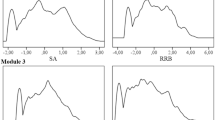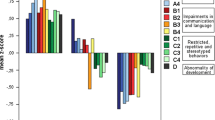Abstract
The current study tested several competing models of the autism phenotype using data from modules 1 and 3 of the ADOS. Participants included individuals with ASDs aged 3–18 years (N = 1,409) from the AGRE database. Confirmatory factor analyses were performed on total samples and subsamples based on age and level of functioning. Three primary models were tested, including a one-factor model, the DSM-IV model, and the anticipated DSM-V model. Results indicated all models fit similarly. Module 1 ratings yielded better indices of fit across all models and higher inter-factor correlations than Model 3. Model fits were impacted by age and level of functioning. The lack of differentiation between models suggests that the structure of ASD symptoms is complex to measure statistically.


Similar content being viewed by others
References
Abrahams, B. S., & Geschwind, D. H. (2008). Advances in autism genetics: On the threshold of a new neurobiology. Nature Reviews, 9, 341–355.
American Psychiatric Association. (2000). Diagnostic and statistical manual of mental disorders–text revised (4th ed.). Washington, DC: APA.
American Psychiatric Association. (2010). DSM-V development: Autistic disorder. http://www.dsm5.org/ProposedRevisions/Pages/proposedrevision.aspx?rid=94. Retrieved March 5, 2010.
Autism Genetic Resource Exchange (AGRE). (2009). The AGRE program. http://www.agre.org/program/intro.cfm?do=program. Retrieved July 7, 2009.
Bollen, K. A. (1989). Structural equations with latent variables. USA: John Wiley and Sons, Inc.
Boomsma, A., van Lang, N. D. J., de Jonge, M. V., de Bildt, A. A., van Engeland, H., & Minderaa, R. B. (2008). A new symptom model for autism cross validated in an independent sample. Journal of Child Psychology and Psychiatry, 49, 809–816.
Brown, T. A. (2006). Confirmatory factor analysis for applied research. NY: The Guilford Press.
Charman, T., Taylor, E., Drew, A., Cockerill, H., Brown, J., & Baird, G. (2005). Outcome at 7 years of children diagnosed with autism at age 2: Predictive validity of assessments conducted at 2 and 3 years of age and pattern of symptom change over time. Journal of Child Psychology and Psychiatry, 45, 500–513.
Constantino, J. N., Gruber, C. P., Davis, S., Hayes, S., Passanante, N., & Przybeck, T. (2004). The factor structure of autistic traits. Journal of Child Psychology and Psychiatry, 45, 719–726.
Dawson, G., Estes, A., Munson, J., Schellenberg, G., Bernier, R., & Abbott, R. (2007). Quantitative assessment of autism symptom-related traits in probands and parents: Broader phenotype autism symptom scale. Journal of Autism and Developmental Disorders, 37, 523–536.
de Bildt, A., Sytema, S., Ketelaars, C., Kraijer, D., Mulder, E., Volkmar, F., et al. (2004). Interrelationship between the autism diagnostic observation schedule-generic (ADOS- G), autism diagnostic interview-revised (ADI-R), and the diagnostic and statistical manual of mental disorders (DSM-IV-TR) classification in children and adolescents with mental retardation. Journal of Autism and Developmental Disorders, 34, 129–137.
Frazier, T. W., Youngstrom, E. A., Kubu, C. S., Sinclair, L., & Rezai, A. (2008). Exploratory and confirmatory factor analysis of the autism diagnostic interview-revised. Journal of Autism and Developmental Disorders, 38, 474–480.
Garson, G. D. (2009). Structural equation modeling. http://faculty.chass.ncsu.edu/garson/PA765/structur.htm. Retrieved February 2, 2010.
Georgiades, S., Szatmari, P., Zwaigenbaum, L., Duku, E., Bryson, S., Roberts, W., et al. (2007). Structure of the autism symptom phenotype: A proposed multidimensional model. Journal of the American Academy of Child and Adolescent Psychiatry, 46, 188–196.
Geschwind, D. H., Sowinski, J., Lord, C., Iversen, P., Shestack, J., Jones, P., et al. (2001). The autism genetic resource exchange: A resource for the study of autism and related neuropsychiatric conditions. American Journal of Human Genetics, 69, 463–466.
Gotham, K., Risi, S., Pickles, A., & Lord, C. (2007). The autism diagnostic observation schedule: Revised algorithms for improved diagnostic validity. Journal of Autism and Developmental Disorders, 37, 613–627.
Gotham, K., Risi, S., Dawson, G., Tager-Flusberg, H., Joseph, R., Carter, A., et al. (2008). A replication of the autism diagnostic observation schedule (ADOS) revised algorithms. Journal of the American Academy of Child and Adolescent Psychiatry, 47, 642–651.
Happé, F., Ronald, A., & Plomin, R. (2006). Time to give up on a single explanation for autism. Nature Neuroscience, 9, 1218–1220.
Jöreskog, K. G., & Sörbom, D. (2004). LISREL 8.7 for windows [computer software]. Lincolnwood, IL: Scientific Software International, Inc.
Kamp-Becker, I., Ghahreman, M., Smidt, J., & Remschmidt, H. (2009). Dimensional structure of the autism phenotype: Relations between early development and current presentation. Journal of Autism and Developmental Disorders, 39, 557–571.
Kanner, L. (1943). Autistic disturbances of affective contact. Nervous Child, 2, 217–250.
Lecavalier, L., Aman, M. G., Scahill, L., McDougle, C. J., McCracken, J. T., Vitiello, B., et al. (2006). Validity of the autism diagnostic interview–revised. American Journal on Mental Retardation, 111, 199–215.
Lecavalier, L., Gadow, K. D., DeVincent, C. J., Houts, C., & Edwards, M. C. (2009). Deconstructing the PDD clinical phenotype: Internal validity of the DSM-IV. The Journal of Child Psychology and Psychiatry, 50, 1246–1254.
Lord, C., & Corsello, C. (2005). Diagnostic instrument in autistic spectrum disorders. In F. R. Volkmar, R. Paul, A. Klin, & D. Cohen (Eds.), Handbook of autism and pervasive developmental disorders, vol.2: Assessments, interventions, and policies (pp. 730–771). Hoboken: John Wiley and Sons, Inc.
Lord, C., Risi, S., Lambrecht, L., Cook, E. H., Leventhal, B. L., DiLavore, P. C., et al. (2000). The Autism diagnostic observation schedule-generic: A standard measure of social and communication deficits associated with the spectrum of autism. Journal of Autism and Developmental Disorders, 30, 205–223.
Mazefsky, C. A., & Oswald, D. P. (2006). The discriminative ability and diagnostic utility of the ADOS-G, ADI-R, and GARS for children in a clinical setting. Autism, 10, 533–549.
Mick, K. A. (2005). Diagnosing autism: Comparing the childhood autism rating scale (cars) and the autism diagnostic observation schedule (ADOS). (Doctoral dissertation, Wichita State University, 2005). Dissertation Abstracts International. 67(6068).
Munson, J., Dawson, G., Sterling, L., Beauchaine, T., Zhou, A., Koehler, E., et al. (2008). Evidence for latent classes of IQ in young children with autism spectrum disorder. American Journal on Mental Retardation, 113, 439–452.
Oosterling, I., Roos, S., de Bildt, A., Rommelse, N., de Jonge, M., Visser, J., et al. (2010). Improved diagnostic validity of the ADOS revised algorithms: A replication study in an independent sample. Journal of Autism and Developmental Disorders, 40, 689–703.
Piven, J., Harper, J., Palmer, P., & Arndt, S. (1996). Course of behavior change in autism: A retrospective study of high-IQ adolescent and adults. Journal of the American Academy of Child and Adolescent Psychiatry, 35, 523–529.
Raven, J., Raven, J. C., & Court, J. H. (2003). Manual for Raven’s progressive matrices and vocabulary scales. San Antonio, TX: Harcourt Assessment.
Robertson, J. M., Tanguay, P. E., L’Ecuyer, S., Sims, A., & Waltrip, C. (1999). Domains of social communication handicap in autism spectrum disorder. Journal of the American Academy of Child and Adolescent Psychiatry, 38, 738–745.
Ronald, A., Happé, F., & Plomin, R. (2005). The genetic relationship between individual differences in social and nonsocial behaviours characteristic of autism. Developmental Science, 8, 444–458.
Ronald, A., Happé, F., Bolton, P., Butcher, L. M., Price, T. S., Wheelwright, S., et al. (2006). Genetic heterogeneity between the three components of the autism spectrum: A twin study. Journal of the American Academy of Child and Adolescent Psychiatry, 45, 691–699.
Snow, A., Lecavalier, L., & Houts, C. (2009). Structure of the autism diagnostic interview-revised: Diagnostic and phenotypic implications. Journal of Child Psychology and Psychiatry, 50, 734–742.
Sparrow, S. S., Balla, D., & Cicchetti, D. V. (1984). Vineland adaptive behavior scales (Survey ed.). Circle Pines, MN: American Guidance Service.
Szatmari, P., Georgiades, S., Bryson, S., Zwaigenbaum, L., Roberts, W., Mahoney, W., et al. (2006). Investigating the structure of the restricted, repetitive behaviors and interests domain of autism. Journal of Child Psychology and Psychiatry, 47, 582–590.
Szatmari, P., Maziade, M., Zwaigenbaum, L., Mérette, C., Roy, M., Joober, R., et al. (2007a). Informative phenotypes for genetic studies of psychiatric disorders. American Journal of Medical Genetics Part B (Neuropsychiatric Genetics), 144B, 581–588.
Szatmari, P., White, J., & Merikangas, K. R. (2007b). The use of genetic epidemiology to guide classification in child and adolescent psychopathology. International Review of Psychiatry, 19, 483–496.
Tadevosyan-Leyfer, O., Dowd, M., Mankoski, R., Winklosky, M. A., Putnam, S., McGrath, L., et al. (2003). A principal components analysis of the autism diagnostic interview—revised. Journal of the American Academy of Child and Adolescent Psychiatry, 42, 864–872.
van Lang, N. D. J., Boomsma, A., Sytema, S., de Bildt, A. A., Kraijer, D. W., Ketelaars, C., et al. (2006). Structural equation analysis of a hypothesized symptom model in the autism spectrum. Journal of Child Psychology and Psychiatry, 47, 37–44.
Wing, L., & Gould, J. (1979). Severe impairments of social interaction and associated abnormalities in children: Epidemiology and classification. Journal of Autism and Developmental Disorders, 9, 11–29.
Wirth, R. J., & Edwards, M. C. (2007). Item factor analysis: Current approaches and future directions. Psychological Methods, 12, 58–79.
Witwer, A. N., & Lecavalier, L. (2008). Examining the validity of autism spectrum disorder subtypes. Journal of Autism and Developmental Disorders, 38, 1611–1624.
Author information
Authors and Affiliations
Corresponding author
Rights and permissions
About this article
Cite this article
Norris, M., Lecavalier, L. & Edwards, M.C. The Structure of Autism Symptoms as Measured by the Autism Diagnostic Observation Schedule. J Autism Dev Disord 42, 1075–1086 (2012). https://doi.org/10.1007/s10803-011-1348-0
Published:
Issue Date:
DOI: https://doi.org/10.1007/s10803-011-1348-0




